Dyspraxia / DCD, Fine Motor Skills, Help for School and Kindy
Step-by-Step Guide to Troubleshoot & Improve Children’s Handwriting Skills
The impact of technology on a child’s development and improve childrens’s handwriting skills
Bridging the gap between the digital world and fine motor skills in children
Handwriting forms a part of our daily lives and remains important in education and eventually employment.
As an adult we don’t take much time to think about why handwriting skills are considered essential. On the surface it seems as if though this skill is rather simple but in reality it is a completely different story. Combining Occupational therapy with fun learning activities will help a child upskill their hand writing skills.
Handwriting is without a doubt one of the most overlooked developmental skills in children. Not only does it develop fine motor skills, but it improves overall spelling and reading skills too. This complex skill evolves over time, and combines memory as well as concentration. It all starts with scribbling which leads to drawing, then words and letters are formed. In this step-by-step guide we cover all the elements of handwriting and we provide practical examples you can use to fine tune their skills.
Recent surveys conclude that 2/3 of American school teachers don’t feel that their educational training gave any emphasis on teaching handwriting skills within the classroom setting.
Do you spend any amount of time talking to parents of preschoolers and kindergartners? Would you agree handwriting is likely one of the top 5 topics of discussion?
Parents are always concerned about their child’s level of accomplishment with handwriting. It seems it is surely behind where they feel their own was at the same age.
Teachers are frustrated that they are inadequately prepared for teaching the finite skills that are the building blocks of handwriting. And, children are frustrated because traditional handwriting drills are tedious and just plain no fun. Amidst this is the questions of how to improve children’s handwriting skills.
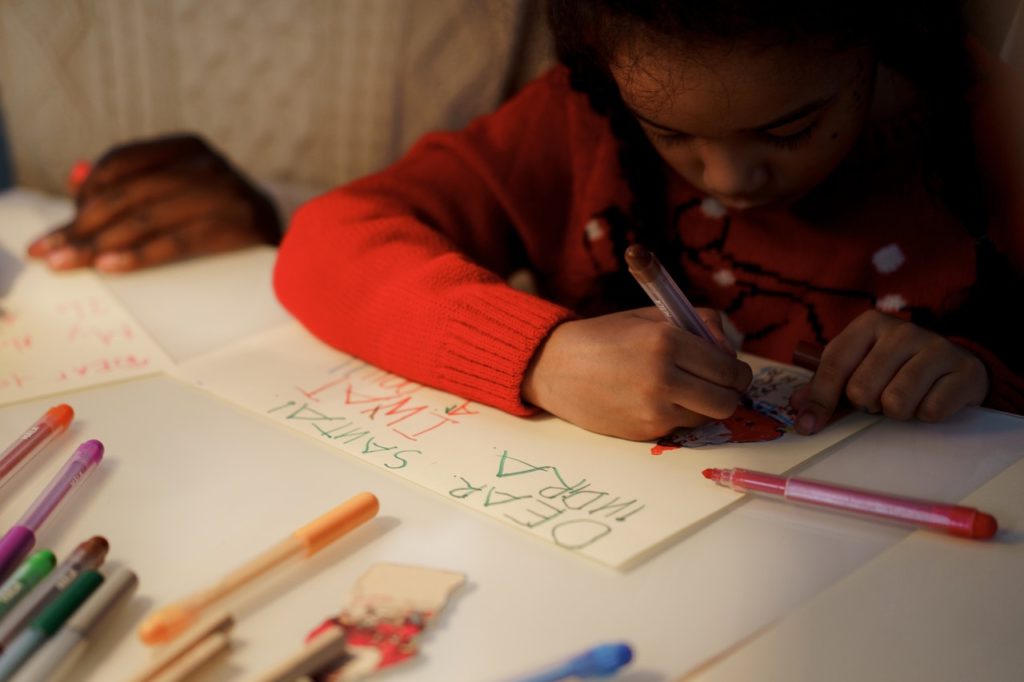
The topic of how to improve children’s handwriting skills has become a hot-button issue. A recent survey concluded that 2/3 of American elementary school teachers don’t feel that their educational training gave any emphasis on teaching handwriting skills.
And a classroom survey revealed that children only receive about 5-10 minutes per week, on average, of exercises devoted to handwriting development during the most important learning period of 3-6 years old.
Occupational Therapy and Children’s Handwriting Skills
As occupational therapists we see that there are so many different reasons a child could struggle with handwriting. It’s no wonder teachers and parents alike find it particularly difficult teaching handwriting skills.
Consider a student that has messy writing, incorrect formation, hates writing, or gives up quickly on handwriting exercises. They could be dealing with any number of issues on a laundry list of seemingly unrelated skills.
But, handwriting is a fundamental life skill. This is a skill that correlates to success in almost every area of life beyond a grade on a school assignment. That’s why we incorporate various specific fine motor skill exercises throughout the progression of each of our therapeutic development programs for kids.
So, regardless of whether a child’s biggest challenge is ADHD, dyspraxia, sensory processing disorder, or Autism Spectrum Disorder (ASD) or even if they don’t struggle with any developmental challenges at all, we encourage teaching handwriting skills and optimal development at every stage.
So, regardless of what a child’s challenge is, we encourage teaching handwriting skills and optimal development at every stage. Whether a child’s biggest challenge is
- ADHD,
- dyspraxia,
- sensory processing disorder, or
- Autism Spectrum Disorder (ASD),
Or even if they don’t struggle with any developmental challenges at all, we still encourage teaching handwriting skills.
So, How Can Teachers Make A Real Difference to Improve Children’s Handwriting Skills?
In our work integrating occupational therapy into everyday classroom settings, we have made some powerful observations. These observations also extend to our Preschool Course in-class programs for teachers.
We’ve observed a few generalities for what seems to work best for teachers working to improve children’s handwriting skills:
- Integrate handwriting games for kids first thing in the morning every single day.
- Make sure your activities are limited to just 5-10 minutes.
- As you observe students with similar difficulties or writing patterns, begin grouping them together to focus on specific exercises to boost their lagging skills.
- Focus on handwriting during handwriting skills, but let mistakes slide once you move on to, say, writing stories or doing math problems. Kids need confidence, and it’s hard to gain confidence in writing when every time they write, they get critiqued on every mistake.
But, what about students who seem to have real challenges with handwriting? The messy penmanship.
The ‘sloucher’ who complains that he’s tired. Or, the discouraged girl who gives up and gets angry?
We will help you to help hone your ability to identify specific challenges in your students’ handwriting problems.
We’ve put together a troubleshooting guide full of assessments and handwriting games for kids. And these don’t have anything to do with letter-writing drills!
10 Step Guide to Troubleshoot & Improve Children’s Handwriting Skills
Step 1: Check for correct/comfortable sitting posture at their desk.
We find that most children haven’t ever been properly taught to sit at an appropriately-sized chair/desk arrangement. The right posture means their arms and hands are free to move at various angles.
Also, paper is to be within reach and able to be angled as needed. And, the child’s posture is to be second-nature and comfortable.
To do this, you’ll need to make sure:
- their writing table is about half the height of the student,
- the student can sit with their bottom all the way back in the chair,
- the student pulls the chair under the table far enough to have their writing work directly over their lap without their belly touching the table edge,
- that the student can lean slightly forward,
- and their elbows can bend fully and freely at their side, not angled out away from their body.
Step 2: Assess physical strength needed for good writing posture.
The core muscles are in the back, stomach and pelvis. Children who have weak core muscles may tend to lie their heads on their desks. Or, they may prop their knees up against the table edge.
When forced to sit in proper posture at a desk, these students tire quickly with writing. Additionally, students may lack the gross motor skills needed to sit up straight. That’s why many of our handwriting games for kids don’t just focus on the hands!
Look at the image below. The angles of the pelvis, knees and ankles are important to leave the hands and arms free to do the task.
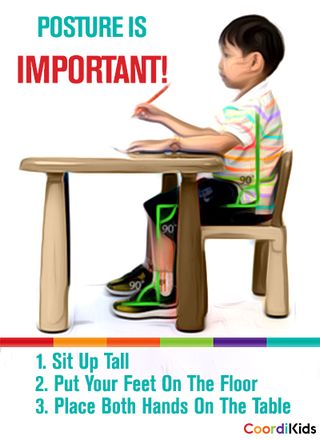
What to do if a student struggles with this step:
Play games that target bilateral coordination & gross motor skills to strengthen the back, stomach and pelvis. These are games such as:
- Crabwalk races – walking on hands and feet, but with them behind you! See our image, below.
- Belly bowling – as it sounds – bowling a ball at skittles, whilst laying on your stomach!
- Lazy 8s – there are various ways to do this, but a black/whiteboard is easy! See our image, below.
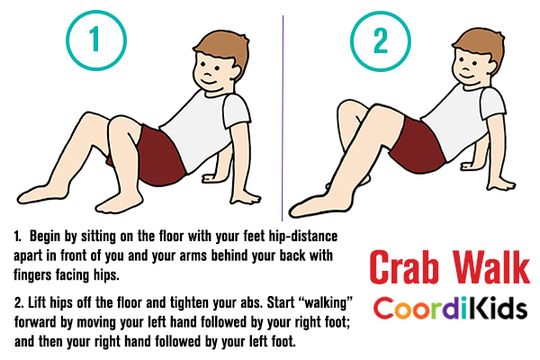
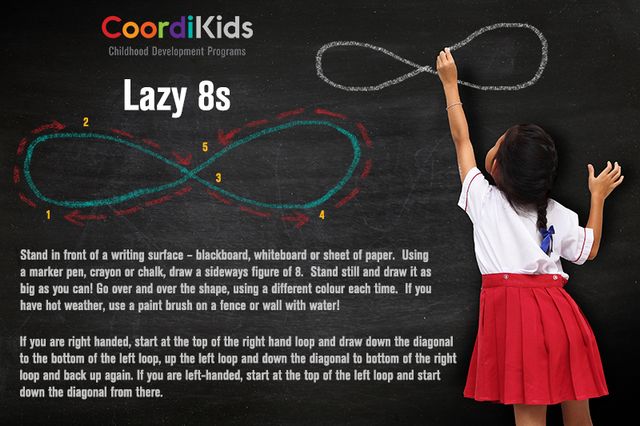
Step 3: Does the student have issues with sensory perception?
Sensory perception (or proprioception, as we OT’s call it) affects a child’s ability to adequately sense the movement of a pencil, send and receive messages to the brain coordinating movement and external sensations, and utilize appropriate pressure to write.
To assess sensory perception, try this fun game. Place a few very differently-shaped items in an opaque bag. Then, ask the student to reach in and identify the items without seeing them.
Another way to assess sensory perception is during painting activities. Does the student have a problem touching finger paints? Do they have a problem dragging his/her fingers through sand and gritty textures?
Or perhaps handling playdough? Does he or she have an appropriate pressure sensation when asked to imprint each finger into playdough? Or to finger-paint as hard as he/she can?
Can the student use minimal force when needed as when picking up a jelly bean without squashing it? Or in manipulating a juice box without spilling any?

What to do if a student struggles with this step:
Sensory processing disorders should be diagnosed by a paediatrician and/or occupational therapist. If you suspect a student is dealing with problems of sensory perception, please refer them to a professional and medical expert. Our Consultations service is available if you would like to contact us.
Here are some sensory perception games that will benefit all students, whether or not they deal with sensory processing disorder. Playing with playdough or modelling clay is a great way to work on sensory perception games to improve children’s handwriting skills.
- Use cookie cutters in very rigid modelling clay to develop pressure strength.
- Make fingerprint flowers and animals that require a print from each individual finger in cold, wet, slimy finger-paints.
- Make small eggs by rolling small pieces of play dough between the thumb and index fingers
Step 4: Does the student have hand/finger strength and coordination?
Dexterity is a student’s ability to manipulate objects with their hands and fingers using fine motor skills and muscle strength.
What to do if a student struggles with dexterity:
Fine motor skills and hand-eye coordination games, such as one called “Piggy Bank”, are great!
Here’s how to play Piggy Bank. In small groups share a piggy bank, or any container with a small slit to drop a coin through. Give each group a pile of coins of any size.
The object of the game is to see how many coins each student can pick up in one hand at once and drop into the slot without dropping any of the rest being held in their fist.
Step 5: Does the student have a dominant hand?
Children naturally begin to show hand dominance between 2 and 5 years of age. It’s an important part of neurological development. Many parents often ask about hand dominance, therefore I wrote in-detail about it here: Handedness in Child Development. Dominant hand – left or right? Sometimes, problems with bilateral integration are a factor in lack of hand dominance.
What to do if a student struggles with this step:
Games that strengthen hand dominance include:
- Lacing or threading
- Grab it! In groups of 2-3 sitting in a circle. Place 5 items in the center of the circle within arm’s length of the students. Call out the name of an item and the first student to grab the item wins the round. In speedy games like this, kids tend to absent-mindedly use their dominant hand.
- Games that encourage the crossing of the midline of the body, such as criss-cross marching. Children without a strong dominant side, tend to swap hands rather than crossing the midline of the body.
Step 6: Does the student use proper grip?
It’s important to teach students a 3-finger pencil grip with equal weight on all three fingers. This ensures they’re using their fine motor skills to manipulate the pencil, not shifting the work to gross motor skills for compensation. The latter will tire the students much faster during handwriting drills.
A child’s pencil grip matures and develops like all other skills. Look at these explanatory images by JHoona Online Magazine:
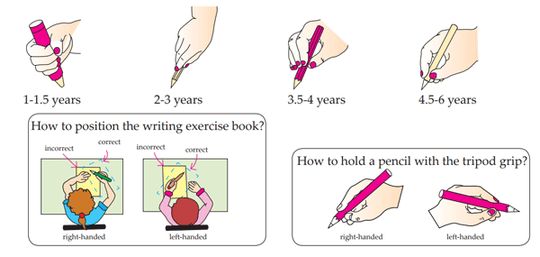
This is a Mature Pencil Grip:

What to do if a student struggles with this step:
Try various grip assists, like the Grotto Grip and these handwriting games for kids that strengthen fine motor skills.
There are many different assisting tools or ‘grip correctors’ available. You can experiment with a few and see which one is the best for your child.
Pincer grip development is essential. We love games with clothes pegs to strengthen small muscles.
Wrapping presents for fine motor skills – see our article here: Gift Wrapping to Help Your Child With Fine Motor Skills Development

Look at this easy and cheap activity to strengthen little fingers! You can start with thin and flexible rubber bands and use stronger rubber bands as your child’s fingers strengthens.
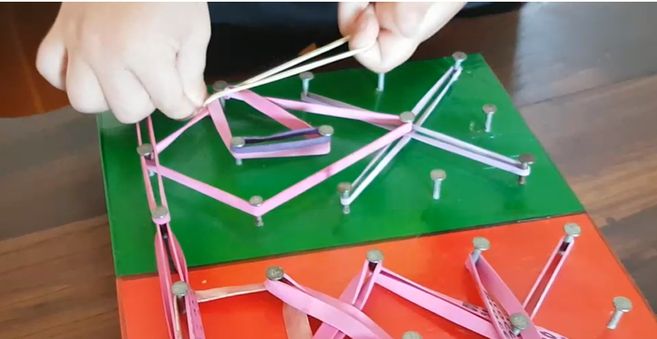
Step 7: Does the student tilt and adjust the paper as needed?
Adjusting the placement of paper is an important, but overlooked, step in handwriting optimization. Observe students to see if they are able to hold the paper in place with their non-dominant hand, move it up slightly as needed, and tilt it to make forming shapes easier.
Children with bilateral integration problems often struggle with this part of handwriting.
Step 8: Assess the student’s abilities with pre-writing patterns and shapes.
Pre-writing patterns include drawing lines, curves, circles, and diagonal lines. It’s important for a child to be able to copy these shapes, as well as being able to initiate the drawing movement from various points and directions.
For example, drawing a straight line from top to bottom as well as from bottom to top.
Some students who have problems with pre-writing may struggle with praxis. Praxis is the brain’s ability to plan and follow a sequence of steps. Learning to write takes a tremendous amount of praxis to learn to manipulate the pencil in sequences from scribbling to drawing lines and shapes, to letter formation in sequence.
Problems with messy handwriting and disorganization in general are common symptoms of dyspraxia. Read more here about dyspraxia: Dyspraxia Symptoms in Children – What to do to Help
What to do if a student struggles with this step:
Dyspraxia should be diagnosed by a paediatrician and/or occupational therapist. If you suspect a student is dealing with problems of praxis, please refer them to a professional and medical expert.
Our Consultations service is available if you would like to contact us. You are also most welcome to contact CoordiKids to organize a webinar or training session with teachers and/or parents.
Here are some prewriting activities and praxis development handwriting games for kids you can use. These will benefit all students, whether or not they have a diagnosis of dyspraxia:
- Drawing and painting on vertical surfaces
- Using variety of media, such as chalk, marker, paint, and drawing with fingers in paint and sand
- Using a variety of sizes and lengths of pencils and crayons
- Lego – you are sure to enjoy our LEGO® Based Therapy article:
- Puzzles
- Mazes
- Sequencing games like dressing dolls
- Pegboard
- Rubber band games and patterns
- Songs using accompanying hand and finger gestures
Step 9: Assess the student’s abilities with letter formation.
Traditional handwriting worksheets for teaching handwriting skills will help teachers assess individual letter formation.
Here, you can focus simply on the shapes and formations, not the specifics of size and consistency. If the humps in an ‘m’ are different sizes, for example, don’t worry.
What to do if a student struggles with this step:
Try to avoid traditional drills of repeating one letter over and over. Just ask the student to do 2-3 repetitions and circle which one they think is the best version. this all will help improve children’s handwriting skills
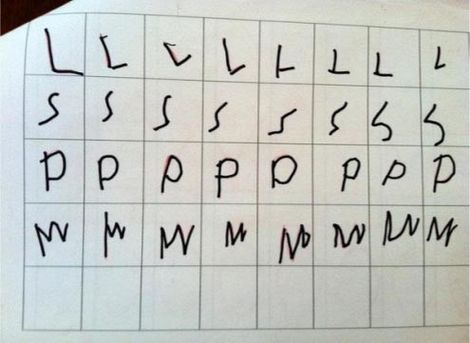
Karin James is a psychologist at Indiana University – her work resulted in this sample of writing. Source:
Step 10: We have additional tips for teaching handwriting skills here
What is CoordiKindy?
This program encourages sensory, fine and gross motor skill development in children aged 3 – 6 years. Our Preschool Course is designed to help you as an Educator to encourage optimal development.
Affordable exercises and activities delivered online are designed by specialist paediatric occupational therapists to pack the best content into videos that run for about 15 minutes. The Preschool Course addresses these common classroom concerns:
Attention
Listening and/or Following Directions
Clumsy Movements
Balance and Basic Movement Skills
Body Awareness
Slowness to Complete Simple Tasks
Learn more about Preschool Course
Everything is very open with a very clear clarification of
the challenges. It was definitely informative.
Your website is very useful. Thank you for sharing!